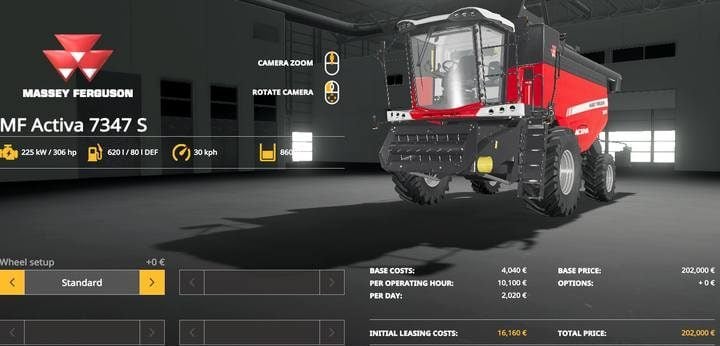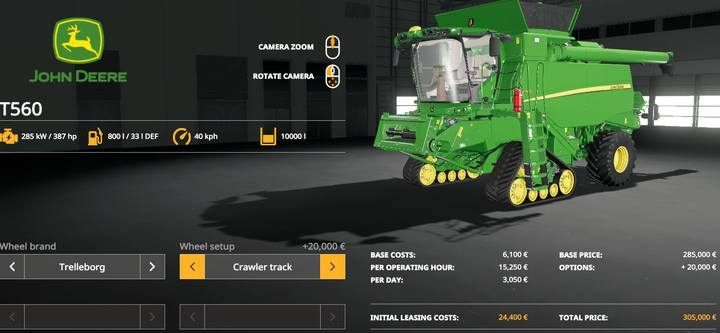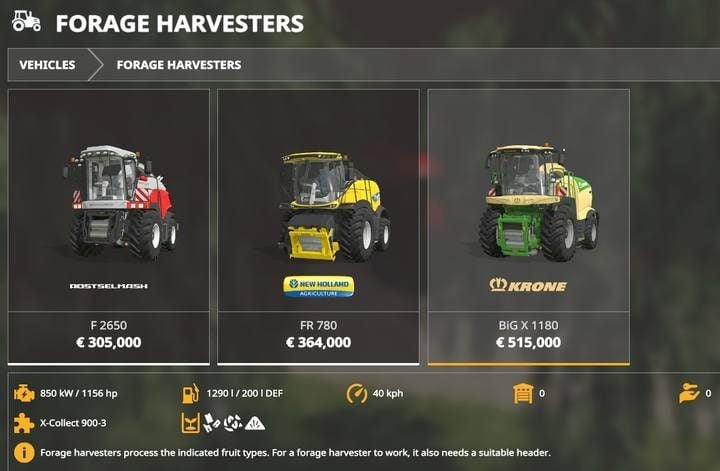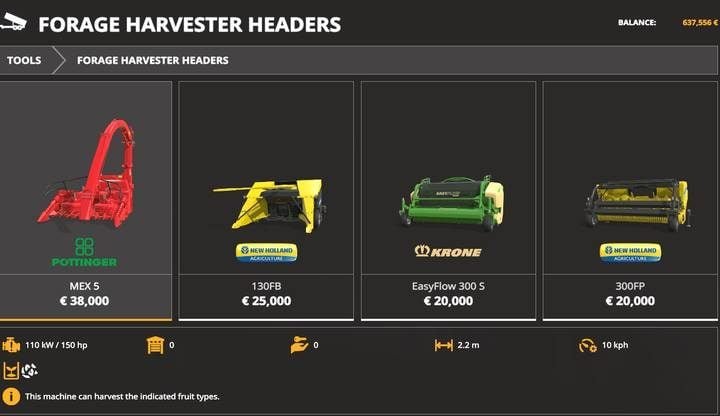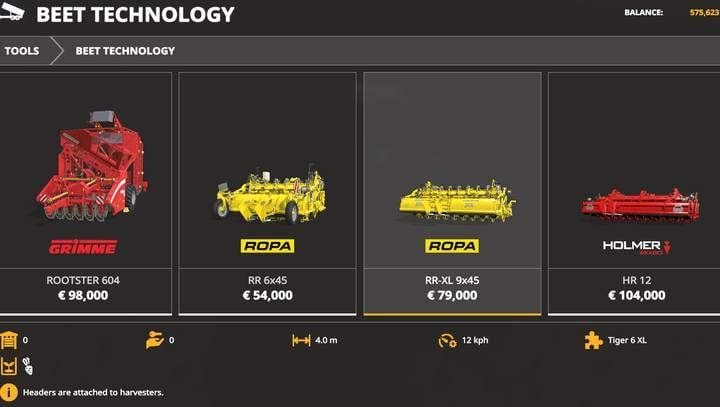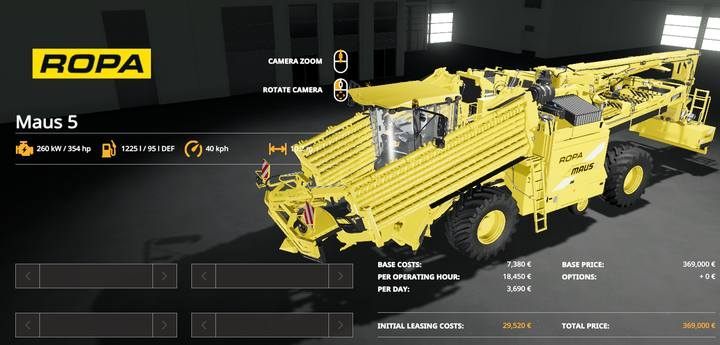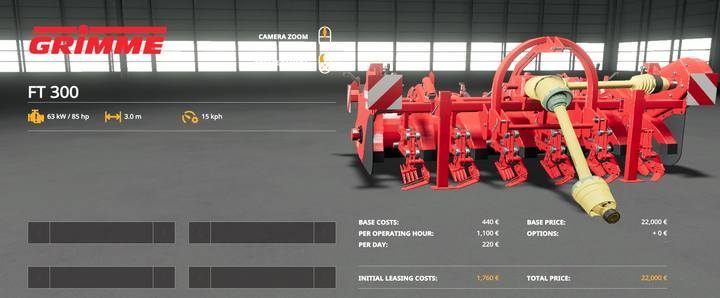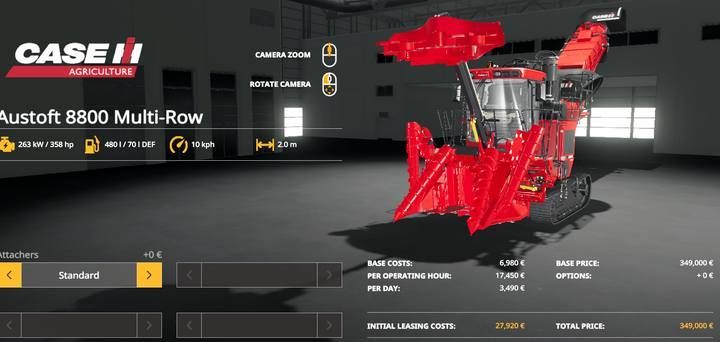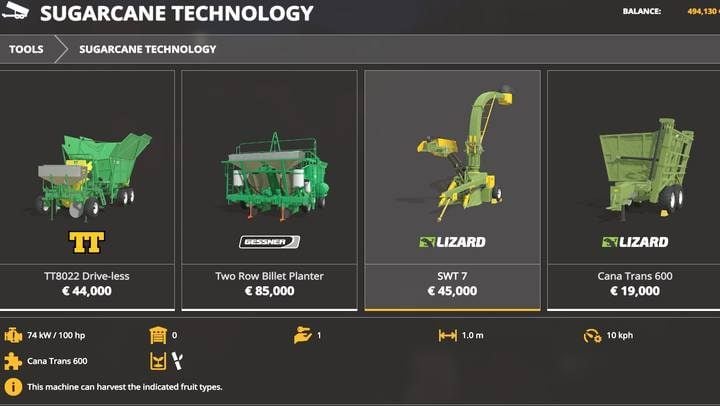Harvesters
In this category you will find 10 harvesters. They differ in power, and thus: width of headers and speed of movement (although in most cases the working speed is the same for each model). The second important difference is the capacity of the tank (so-called hopper) – i.e. information on how many crops can it accommodate before it will have to be emptied. Harvesters are used to harvest wheat, barley, oats, rape seed and soybeans, as well as sunflower and maize. To most harvesters (except for models for $100,000) you can connect loading trailers and empty the crop to them.
FMT Bizon Super ZO56 is the cheapest ($84,000) available harvester. I do not recommend buying it, mainly because of the very small grain tank. You can’t connect headers from other models to it (which is possible with other combine harvesters). The advantage, however, is the ability to connect TDK/HDK trailers, to which you can empty the harvester during breaks.
If you don’t want to pay a fortune for a harvester at the beginning of the game, the Massey Ferguson MF Activa 7374S ($202,000) is a good solution. Thanks to its powerful output, you can attach 9m headers to it, intended for more expensive models. This harvester can handle them without any problems, maintaining maximum speed, provided that it does not get damaged and if the field is flat.
The John Deere T560 and S790 harvesters differ from other models in that they can be upgraded with front axle tracks. This greatly improves their mobility and maneuverability.
Headers for Harvesters
Each harvester needs an attachment, so-called header, to be able to work. In the Header category in the store you will find those that allow you to harvest wheat, barley, oats, rape seed and soybeans. Here you will also find special headers for harvesting sunflower: they are characterized by the fact that the harvester can then work at a speed of 15 km/h. In the Corn Headers category you will find those that allow you to harvest corn and sunflower (but the sunflower will be harvested at a speed of only 10 km/h).
- You can mount different headers on different harvesters, although each of them has its own dedicated one, which ensures effective work in all conditions.
- Differences between headers of the same type are only price and their width. For example, if a 9m-wide header is dedicated to a given harvester, you can also install another company’s header, if it is cheaper – it will work with the combine harvester.
- You can mount a header wider than the one recommended for the harvester, but there is no guarantee that it will run at full speed: you can lose on this change.
- An exception to the above is the Bizon Super ZO56 FMT harvester – you can connect only dedicated headers to it and it does not have a header for quick corn harvest.
Some grain hedgers are purchased with a system of wheels and drawbar to transport them freely on the roads. However, if you buy a model that is too wide to travel on the road, use dedicated Trailers for harvesters/cutters that have their own category in the store and cost a penny.
Forage Harvesters
The forage harvesters have three applications, depending on which headers you attach to them:
- They are mainly used to obtain chopped straw, which can be sold or converted into silage, which is quite a profitable business.
- Chopped straw can be acquired from wheat, barley, oats, rapeseed and soybeans, using headers for $38,000.
- The most profitable chopped straw is made from corn: other headers are used for this purpose, which you will find at the end of the forage harvester headers tab.
- They can collect cut grass and transfer it to any trailer, instead of using bale technology or forage wagons.
- They can cut poplars to obtain wood chips, which are sold in a sawmill.
Each of the three models is characterized only by power, and thus – the width of applicable headers. They don’t have their own tanks, so you need to use an additional vehicle with a semi-trailer on the side so that the collected raw materials will be directly transferred to the semi-trailers.
Trailers for transporting chopped straw, grass, hay, straw, chips and sugarcane.
However, each of the forage harvesters has a pin at the back that allows the attachment of some trailers: standard HDK/TDK or special large capacity trailers, found in the Sugarcane technology category. You cannot use loading wagons, because they do not accept this type of crop.
Forage Harvester Headers
In the store, you can find Forage Harvester Headers. Be careful with shopping:
- Pottinger MEX 5 is only compatible with tractors and is a small version of the harvester for chopped straw harvesting only from coulters. Remember to place the trailer behind the tractor.
- Header New Holland 130FB as the only one to extract chips in a planted poplar. In spite of the game suggestion that this is a header to the NH FR 780 forage harvester, you can attach it to any model.
- More headers for $20,000: EasyFLow 300 S and 300 FP are used to collect cut grass or hay by a forage harvester. This is a great replacement for the slow harvesting of grass via the loading wagons.
- Headers for $38,000: XDisc 620, Spartan 610, 600FDR – you can also use them interchangeably in different harvesters; they are used to extract chopped straw from wheat, barley, oats, soy, and rape.
- Headers for $80,000 and $120,000: 360 Plus, 390 Plus, SFI 900 and X-Collect 900-3 are used to extract chopped straw from corn, exclusively. However, this is the most efficient method of obtaining chopped straw harvesting: these headers work slower (speed 10 km/h in relation to grain headers: 15 km/h), but they have a 50% wider tip. The most important thing is that you will get more than 2x more chopped straw from corn than any other cereal.
Potato Harvesters
The self-propelled combine harvester Grimme Varitron 470 Platinum Terra Trac ($496,000) can be found in the vehicle category in the shop under Potato technology. It is completely self-sufficient and does not require the use of headers or the cutting of potatoes before harvesting. It is, however, expensive and designed for large harvests. But don’t be fooled by the tank capacity (9590l) – it fills up very quickly and you have to be prepared to empty it.
There are two more models of potato harvesters that require a tractor to operate. Compared to a self-propelled combine harvester, they are much slower, have a lower harvesting capacity (and need a tractor).
- The Grimme SE 260 model – to use it, connect it to the tractor at the rear and install a potato cutter at the front before digging: Grimme KS 75-4. Do not use this combine harvester – just buy the next one. This one poses considerable problems, especially when it is used by the employees: if you connect both mentioned devices to the tractor and hire an employee, he will skip every second potato strip, because the cutter tip is twice as wide as the width of the combine harvester.
- Ropa Keiler 2 – taking into account the purchase price of the combine harvester and the bit for the above model, you will pay the same amount. This harvester doesn’t need the front end, so you can use it even on a harvester that doesn’t have a 3-point front linkage. It also uses less tractor power.
Beet Harvesters
Three beet harvester models are available for beet harvesting. However, they do not differ much from each other, and for such a machine you have to pay a lot – it is worth to buy it only when you want to cultivate beets in bulk. You can also connect pin-mounted trailers to these combine harvesters: HDK/TDK, but it doesn’t matter if you’re harvesting in bulk.
These headers can be found in the Technology of beet growing tab in the shop. This time, however, it is not advisable to mount headers from another model on a weaker combine harvester, as they differ in width.
The beet harvester, just like the potato harvester, fills up quite quickly. For this reason, special beet harvesting machines have also been developed, which can also be found in the beet harvester category, such as Ropa Maus 5. Allows beet to be loaded from the ground. In other words: with such a machine you can empty the combine harvester to the ground, and then load the entire crop onto trailers quickly and easily.
For beginners, there is also a small beet harvester Grimme Rootster 604 attached to the tractor (you can also find it in category Technology of beet growing). It so happens that it is a pretty good machine. Compared to the problematic potato harvester, it works quickly and efficiently and does not require a powerful tractor engine.
As with potatoes, the beetroot topsides must be cut before harvesting, so install the Grimme FT 300 at the front of the tractor. There are, however, two things to note:
- This tool requires the tractor to have a drive shaft for this device, so it cannot be any 3-point-mounted tractor,
- This tool moves at a speed of 15km/h, whereas the combine harvester moves at a speed of 10km/h. So, you can also run these tools independently (e.g. cut the blades with one implement and collect the beets with two harvesters; or simply separate the operations so as not to overload one, weak tractor).
Cotton Harvester
As cotton is a new crop in the Farming Simulator 19, not many machines were prepared for its harvesting. There is only one choice for harvesting: combine harvester CaseIH Module Express 635. You don’t need any additional tools or headers to operate it – it’s ready to go after purchase. When the tank is full (from the collection of approx. 2ha), it places a large bale of cotton on the ground, which you will harvest with special trailers.
Sugarcane Harvester
The main device for harvesting sugar cane in the Farming Simulator 19 is a large self-propelled combine harvester: CaseIH Austoft 8800 Multi-Row. However, this is not a very interesting proposition – it has twice as much harvesting area as a combine harvester connected to a tractor (but with the same speed), but for this price, you will buy two small tractors with combine harvesters instead of one large one. After installing the modification in the store, it has the ability to connect a trailer to it, but only a small one – large trailers don’t fit because of the massive pipe for depositing crops.
The combine harvester Lisard SWT 7 is a cheaper harvester for harvesting sugar cane. It’s attached at the rear of the tractor like a semi-trailer, but behind it, you can attach a large trailer to harvest the cane and hence make it easier to harvest the cane, as the cane generates a large harvest. However, I recommend using the trailer Massey Ferguson MF 3012 because after using a large Randon trailer, the field worker often leaves large, uncollected areas.

